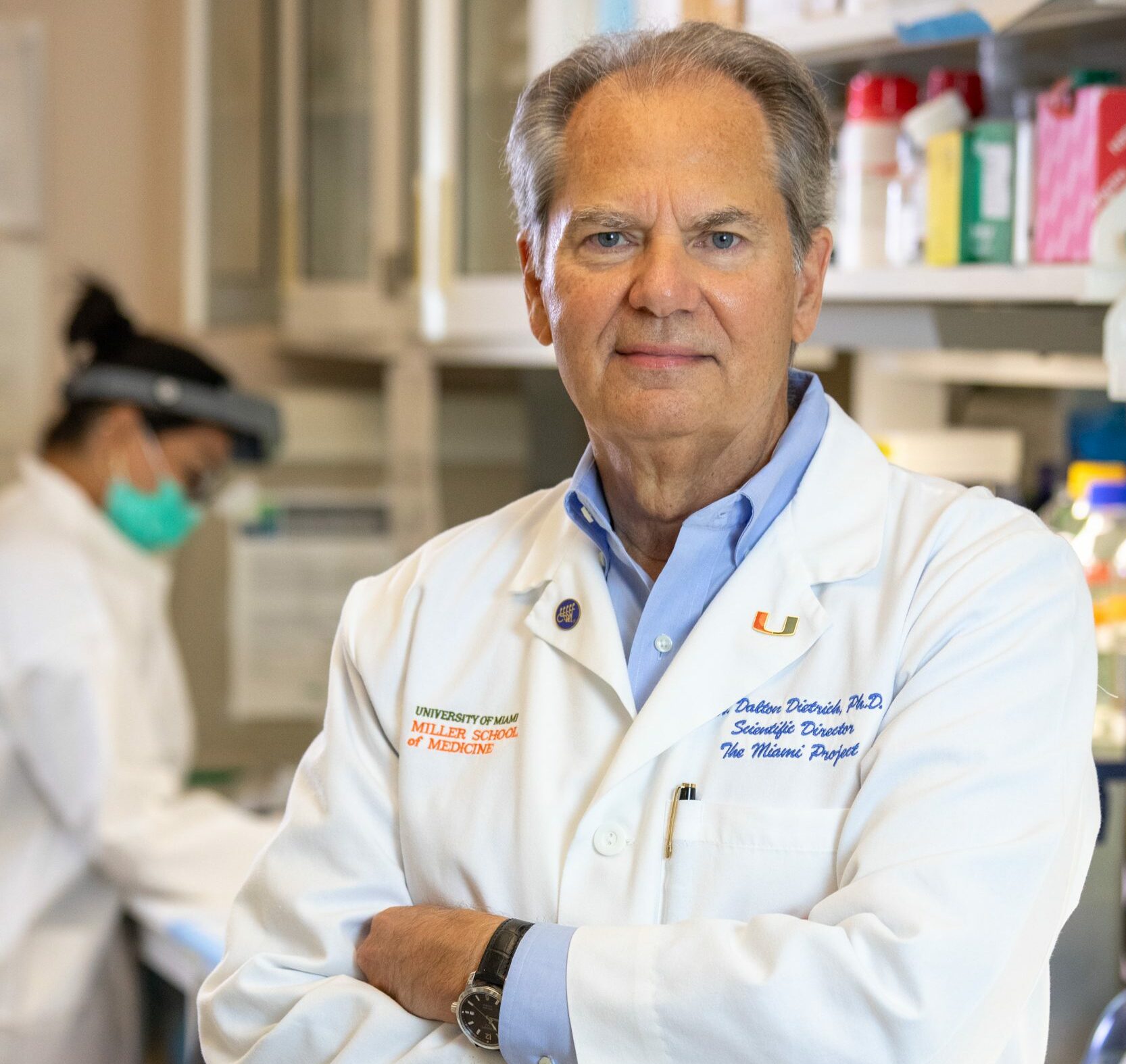(October, 2024) Neurotrauma to the brain and spinal cord is a significant public health concern, impacting nearly 1.5 million Americans. Within this demographic are military personnel facing unique neurotrauma challenges. Researchers at The Miami Project to Cure Paralysis, a Center of Excellence at the University of Miami Miller School of Medicine, are answering the call for new diagnostic and therapeutic agents in this group thanks to a $1.7 million grant from the U.S. Department of Defense (DOD).
The DOD awarded the two-year grant for the project “Army Battlefield Exercise and Combat-Related Traumatic Brain Injury (TBI) and Spinal Cord Injury (SCI),” which was backed by U.S. Representative Debbie Wasserman Schultz. SCI is a common combat injury with thousands of veterans living with various chronic disabilities. Likewise, TBI occurs in military personnel following cases of blunt head injury, shrapnel, or a blast wave from exploding bombs.
“We were very pleased that our grant application was well received by the grant review boards and recommended for funding,” said W. Dalton Dietrich, Ph.D., scientific director of The Miami Project and professor of neurological surgery. “The multidisciplinary program will allow our researchers to generate new data to further support future investigations and clinical translation.”
Team-Science Approaches to Military Neurotrauma
Six projects from the center are in the works, focusing on discovery, translational and clinical research. These research enterprises are directed at testing novel diagnostic and treatment approaches for acute and chronically injured patients.
From 2001–2009, the DOD reported 5,928 new SCIs within the armed forces, a rate almost eight times higher than that of the general U.S. population. Further emphasizing the scale of the issue, the Defense and Veterans Brain Injury Center highlighted nearly 414,000 TBIs among U.S. service members worldwide from 2000 to late 2019.
“Ongoing research into neurotrauma often highlights the need for better predictive tools that can accurately determine the outcome of various interventions,” Dr. Dietrich said. “This would personalize treatment plans and optimize resource allocation.”
The first project, led by Hassan Ali, Ph.D., M.S.M., associate professor of neurological surgery and medicine, Vance Lemmon, Ph.D., professor of neurological surgery and John Bixby, Ph.D, professor of pharmacology and neurological Surgery emeritus will investigate lead kinase inhibitors with polypharmacological properties and how they will signal multiple pathways involved in cell communication, particularly those related to the regeneration of nerve fibers.
For project two, Damien Pearse, Ph.D., professor in the Department of Neurosurgery, Aisha Khan, executive director of Interdisciplinary Stem Cell Institute, laboratory operations, and W. Dalton Dietrich Ph.D. will test the safety and benefits of Schwann cell-derived exosomes in a model of SCI.
Neuromodulation Use in Spinal Cord Injury
The following three projects will be led by James Guest, M.D., PhD., clinical professor in the Department of Neurology; Matija Milosevic, Ph.D., director of neuromotor rehabilitation; Mark Nash, Ph.D., associate scientific director of research and Patrick Ganzer, Ph.D., assistant professor in the Department of Biomedical Engineering.
Each of their respective applications focuses on utilizing state-of-the-art neuromodulation to improve specific functions in individuals living with SCI. Project three will focus on arm and hand function, while the fourth project will utilize transcutaneous stimulation to produce locomotor function based on signals from the brain. The fifth project will evaluate the benefits of transcutaneous vagal nerve stimulation on glycemic homeostasis.
“New strategies for the stimulation of residual circuits after neurotrauma combined with task-specific motor activity are showing real results” said Dr. Guest. These neuromodulation approaches are not only improving motor function but also other quality of life issues that people are living with”.
Finally, project six, led by Pablo de Rivero Vaccari, Ph.D., M.S.B.A., associate professor in the Department of Neurological Surgery, Ayham Alkhachroum, M.D., assistant professor of clinical neurology, and Robert Keane, Ph.D., Professor of Physiology and Biophysics, will evaluate a blood biomarker diagnostic platform as a potential surrogate marker for advancing behavioral improvements.
“After traumatic brain injury, when patients are in the intensive care unit, physicians and families are often faced with extremely critical life or death decisions,” Dr. Vaccari said. “Using a blood-based biomarker approach combined with clinical data from eye tracking and EEG patterns, we aim to identify complementary and novel information that can better educate all parties involved when making decisions about the care of comatose patients after brain trauma.”
These studies, which will span the next two years, will feature collaborative team science, with results communicated at conferences and peer-reviewed journals.
“Managing these injuries doesn’t stop at the hospital exit; it’s a lifelong journey of adaptation and rehabilitation,” Dr. Dietrich said. “For military and civilian personnel, life after such injuries involves navigating many challenges. This transition requires comprehensive support systems, including physical therapy, mental health services, and community reintegration programs. Our overreaching goal is to develop and test new approaches that can help repair the nervous system and promote improved function to ensure individuals can lead fulfilling lives post-injury.”
By: Joey Garcia

